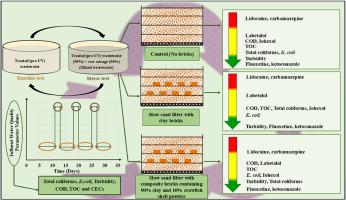增强了3d打印砖在不同条件下处理废水的能力
IF 8.4
2区 环境科学与生态学
Q1 ENVIRONMENTAL SCIENCES
引用次数: 0
摘要
本研究通过将传统的慢砂过滤与粘土或粘土-小龙虾壳复合材料制成的3d打印砖相结合,探索了一种可持续且经济实惠的废水处理方法。基于使用uv预处理废水作为进水的初步研究结果,目前的研究实施了压力测试,以评估反应器如何有效和快速地应对在存在泄漏、处理厂故障和/或农村和服务不足社区的情况下可能发生的进水成分突然变化。三次压力测试(给水:50%原水和50% uv预处理废水;每次压力测试的平均持续时间:2天),然后是参照基线测试的三个恢复阶段(给水:100%紫外线预处理废水;每个回收阶段的平均持续时间为5 d)使用三个反应器进行:1)复合砖(按重量计粘土占90%,小龙虾壳废料占10%)和沙子的反应器,2)粘土砖和沙子的反应器,3)仅沙子的反应器(对照)。从浊度、化学需氧量(COD)、总有机碳(TOC)、总大肠菌群、大肠杆菌和46种新兴关注污染物(CECs)等方面对反应器的性能进行了评价。虽然浊度去除效率在整个研究过程中保持稳定(~ 90%),但与基线测试(分别为~ 40%和~ 45%)相比,在三个系统中,在压力测试期间(分别为~ 50%和~ 80%)实现了更高的COD和TOC去除效率。在研究结束时,小龙虾反应器对总大肠菌群和大肠杆菌的去除效果增强。在检测到的CECs中,氟西汀、酮康唑和咪康唑被完全去除,与反应器的性质无关(粘土砖与粘土、小龙虾砖与对照)。在有粘土砖的反应器中,甲氧苄啶(+ 6%)的去除率得到了提高,而在有粘土和小龙虾砖的反应器中,拉贝他洛尔(+ 22%)、碘己醇(+ 31%)、利多卡因(+ 21%)和卡马西平(+ 20%)的去除率得到了提高。除卡马西平在小龙虾砖反应器中的去除率显著高于粘土砖反应器(p = 0.01)和对照组(p = 0.02)外,三种反应器对分析物的去除率无统计学差异。本文章由计算机程序翻译,如有差异,请以英文原文为准。

Enhanced ability of 3D-printed bricks to treat wastewater under variable conditions
This study explores a sustainable and affordable approach to wastewater treatment by combining traditional slow sand filtration with 3D-printed bricks made from clay or a clay-crawfish shell composite. Building on the findings from a preliminary study using pre-UV treated wastewater as the influent, the current study implemented stress tests to assess how effectively and quickly the reactors could respond to sudden changes in influent composition potentially occurring in the presence of a spill, a malfunctioning treatment plant, and or in rural and underserved communities. Three stress tests (feed water: 50 % raw wastewater and 50 % pre-UV treated wastewater; average duration of each stress test: 2 d) followed by three recovery phases referred to baseline tests (feed water: 100 % pre-UV treated wastewater; average duration of each recovery phase: 5 d) were conducted using three reactors: 1) a reactor with composite bricks (90 % clay and 10 % crawfish shell waste by weight) and sand, 2) a reactor with clay bricks and sand, and 3) a reactor with only sand (control). The reactors' performance was evaluated in terms of turbidity, Chemical Oxygen Demand (COD), Total Organic Carbon (TOC), total coliforms, E. coli, and 46 contaminants of emerging concern (CECs). While turbidity removal efficiency remained stable throughout the study (∼90 %), higher COD and TOC removal efficiency were achieved during the stress tests (∼50 % and ∼80 %, respectively) compared to the baseline tests (∼40 % and ∼45 %, respectively), across the three systems. The crawfish reactor enhanced the removal of total coliforms and E. coli towards the end of the study. Among the detected CECs, fluoxetine, ketoconazole and miconazole were completely removed regardless of the nature of the reactor (clay bricks vs. clay and crawfish bricks vs. control). Enhanced removal in terms of trimethoprim (+6 %) was achieved in the presence of the reactor with clay bricks, while enhanced removal of labetalol (+22 %), iohexol (+31 %), lidocaine (+21 %), and carbamazepine (+20) was achieved in the presence of clay and crawfish bricks. Regarding the analytes’ removal, there was no statistical difference among the three reactors, except for carbamazepine, which was significantly higher in the crawfish brick reactor compared to the clay brick reactor (p = 0.01) and the control (p = 0.02).
求助全文
通过发布文献求助,成功后即可免费获取论文全文。
去求助
来源期刊

Journal of Environmental Management
环境科学-环境科学
CiteScore
13.70
自引率
5.70%
发文量
2477
审稿时长
84 days
期刊介绍:
The Journal of Environmental Management is a journal for the publication of peer reviewed, original research for all aspects of management and the managed use of the environment, both natural and man-made.Critical review articles are also welcome; submission of these is strongly encouraged.
 求助内容:
求助内容: 应助结果提醒方式:
应助结果提醒方式:


